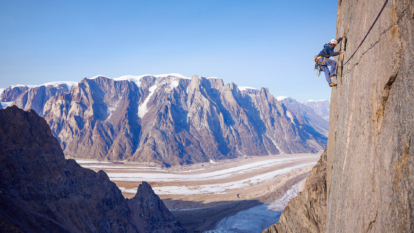The Wall as a Mirror
Listen to the story
All photos by Ben Ditto
Captions by Sean Villanueva O’Driscoll
It’s hard to let go. We were just over halfway up a king line on a nearly 4,000-foot wall, but it felt like we were really close. An obvious crack system seemed to lead all the way to the top, a mere 98 feet above us. But, this was it. This is the game we play. There was nothing more to try.
We had started the expedition two months earlier. Our climbing team consisted of me; Nicolas Favresse, whom I have been adventuring with for more than 25 years; climber-photographer Ben Ditto, who had been part of two of our previous sailing and climbing expeditions; and Franco Cookson, a bold headpoint climber with no sailing or big-wall experience but who was very keen to try both. We had 7 days of preparing the boat in Scotland, 16 days of sailing (most of which I spent vomiting), 5 days in the Faroe Islands waiting for a storm to pass, 14 days in Iceland waiting for the pack ice in Eastern Greenland to clear, 10 days of hiking back and forth carrying heavy loads over endless moraine and treacherous glacier, then 9 days of physically and mentally draining climbing, wrestling with loose rock, perilous skyhooks and massive runouts.
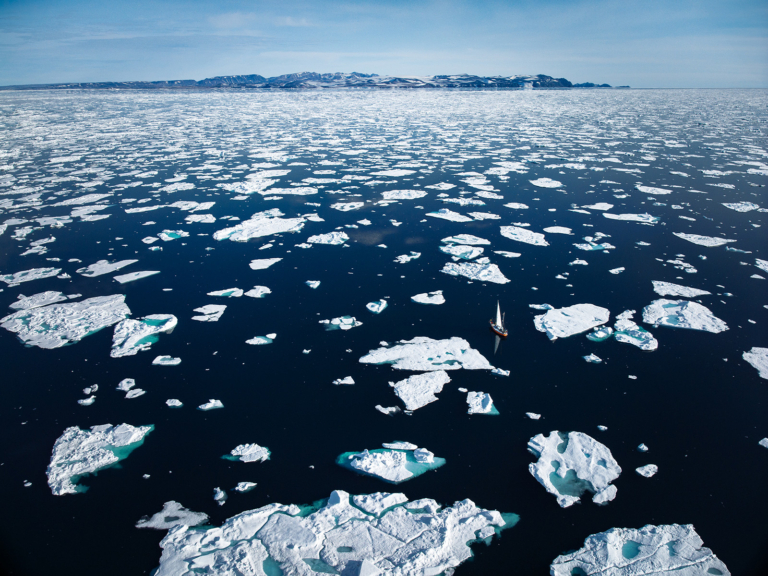
The 46-foot Cornelia weaves its way through a labyrinth of ice after crossing the Denmark Strait. This was my fourth sailing-climbing expedition to Greenland.
Our objective was the Mirror Wall, a massive shield of shining granite standing proud in a sea of ice, deep inside the fjord of Scoresby Sund on the east coast of Greenland. Even though our approach was long, involved and arduous, we enjoyed every second of it.
That we had made it this far was astounding. There had been many moments of uncertainty that put us on the verge of bailing. As we were meandering our way through steep waves of grey scree and opalescent walls of ice on our very first day of hiking toward the Mirror Wall, a big granite block slid from under Nico’s foot. He fell into a pool of icy water and found himself with a deep gash on his upper shin. Anywhere else this would have been minor, just a matter of a few stitches and letting it heal. But here, days away from the nearest medical facility, the possibility of infection was very serious. Nico had put a lot of effort into preparing for this trip, and it seemed that his expedition was over before we had even gotten to see the Mirror Wall. However, Nico accepted his fate with good spirits and returned to the boat to recover from his injury as the three of us continued ferrying gear and food to the base of the wall. Ten days later, just as we were ready to start climbing, Nico’s wound had healed enough that he decided it was worth taking the risk to join us. However, after two days of intense effort hauling heavy, nearly 220-pound bags up the wall, his wound started showing signs of infection. He was forced to start antibiotics and avoid exerting himself by staying at the portaledge camp, cooking, reading and playing music.
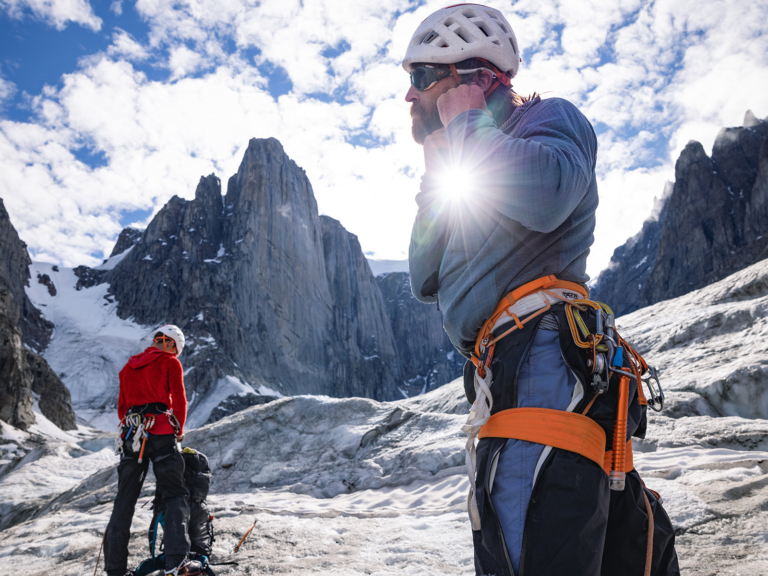
Here, we’re at advanced base camp and doing recon of the glacier beneath the Mirror Wall. When I first saw the wall, it ignited a spark in my chest.
The rest of us slowly continued fighting upward, with several days of complex route-finding that felt like nine-hour games of chess to progress just 131 feet. After getting past some of the blankest sections of the wall, we finally arrived at a right-facing dihedral, one of the rare distinct features on the first half of the face. We expected straightforward climbing—instead, the corner was completely closed, with no possibilities for pitons or beaks, and the rock was flaky, exfoliating and sandy. Using friction with my palms and feet on opposing sides of the dihedral, I pushed my way upward for about 65 feet. With skepticism, I placed a skyhook onto a razor’s edge and, holding my breath, slowly added weight to it.
Time always seems to stand still as you commit to a skyhook. It will either hold and you will hang like a sack of potatoes, or before you know it the hook will ping off, or the edge will break and you will be flying through the air. This time it held. Hanging off one point of contact on a 4-millimeter-wide edge, I carefully placed the hand drill against the rock surface and started whacking it with the hammer. An hour later, I clipped the rope into the safety of a bolt.
Thirteen feet higher I could see a flake that would clearly take a cam. Up I went, pushing the two walls apart, gritty rock crackling under my feet. It was precarious, insecure climbing with no pulling, only pushing, farther and farther away from the bolt. The flake was near, but just out of reach to my right. I scanned the surface.
Just give me something, I thought, a foothold, a razor, a crystal, anything. There was nothing.
With no option to go right, I continued stemming higher, away from the flake and the bolt. Grunting for courage, I pushed deeper and deeper into a dark sea of uncertainty until, paralyzed by fear, I couldn’t go any higher. My calves were screaming, my body shaking. I looked up but there was nothing to aim for. I looked down and the bolt was far away. I heard myself scream as I flew through the air until the rope caught me almost 33 feet below.
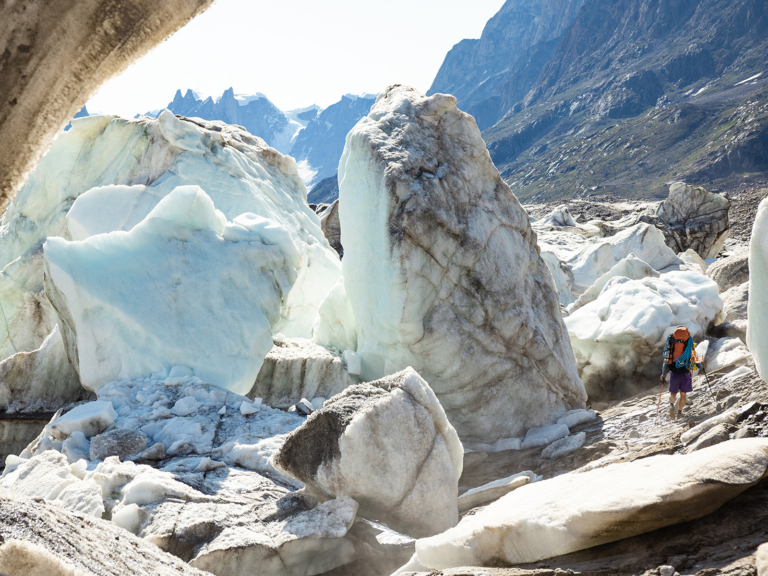
The approach was as magical as the wall itself. Some sections felt like walking through a Salvador Dalí painting.
For two days I tried this section, taking frightening fall after fall. On one, I hit the wall and hyperextended my right foot, leaving my ankle swollen and blue. Luckily it was just a little painful, not debilitating. I tried aid climbing, but any edge would break as soon as I tried to put weight on the skyhook. Copperheads refused to stick to the soft sandy rock, and peckers would just bounce back. We were running out of options.
Maybe if I placed two bolts in a row I could reach the flake? I thought. Or maybe it would be just out of reach and then I would have to place another bolt. And maybe a little higher up there would be another blank, featureless section that is just a little longer than the last one, and we would have to place an even longer bolt ladder. We didn’t know.
We’ve always tried to avoid placing bolts whenever possible. Most of our first ascents don’t have any bolts. But even though there are edges for free climbing on Mirror Wall, it’s mostly void of cracks and seams, offering very limited natural protection. We knew we would have to place bolts to make it to the summit.
In his 1971 essay “The Murder of the Impossible,” Reinhold Messner writes, “a combination of bolts and single mindedness will get you up anything.” With a bolt ladder and a bolt at every arm’s reach, you can manage your way up the smoothest of rock faces. But to us, it makes no sense to force an illogical route up a blank face. Standing at the base of the Mirror Wall, we decided we would not place a bolt from a bolt. There had to be a certain distance between bolts, with either free climbing or difficult aid climbing between them. Maybe this is rather subjective and very dependent on skill, strength and courage. But a line must be drawn if you don’t want to murder the impossible. In some ways, the impossible is what makes climbing worthwhile. The fact that you won’t be able to climb all the walls, that some will always keep you dreaming.
Climbing, like life, is a game with values. These values are arbitrary, pure convention, made up. But they are what give climbing its essence. It cannot be the summit above all. You have to keep the challenge alive. You have to give failure a chance, too.

Left: While walking through a narrow gully on the first day of our approach, I heard a loud splash behind me. I turned around and saw Nico had fallen into a deep pool of icy water and was getting pulled down by his heavy pack. I was worried he would drown, but he managed to pull himself out quickly. “OK, let’s keep walking to avoid getting cold!” he said, which was quickly followed by, “Oh shit, I’m bleeding.” The gash on his shin went down to the bone.
Right: From shore to the base of the Mirror Wall, it’s almost 19 miles of crevasse-strewn glaciers, sandy desert and never-ending moraine. It took us around 10 days of laborious route-finding to carry our heavy loads of gear and food back and forth from the boat to the climb.
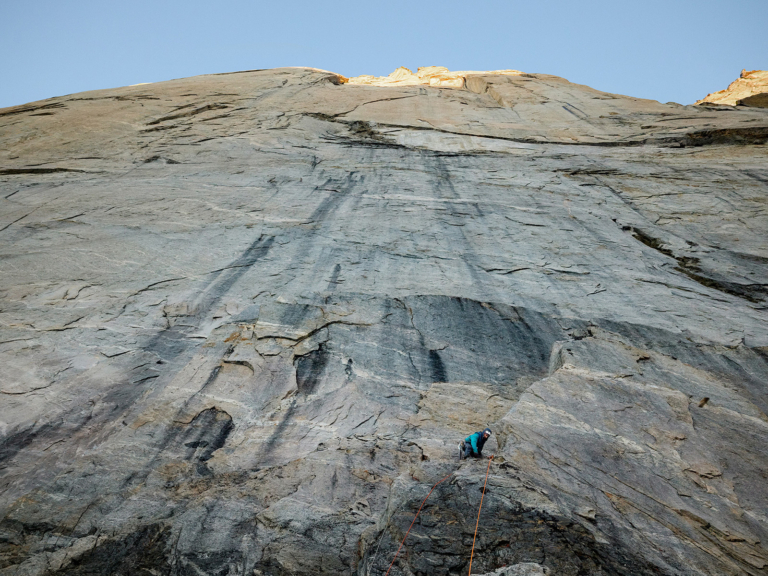
The first time we stood below the Mirror Wall, we were smacked in the face by the challenge ahead. It was clear that this was going to be the most ambitious climb we had ever attempted. There were no obvious crack systems or lines of weakness, just a big, steep, featureless shield of granite. We had dreamed about this face for months, and it had taken so much time and effort to get here. We weren’t going to walk away. With a mix of fear and excitement, we committed to a line. It’s better to live with the courage to try than with the fear of failure.
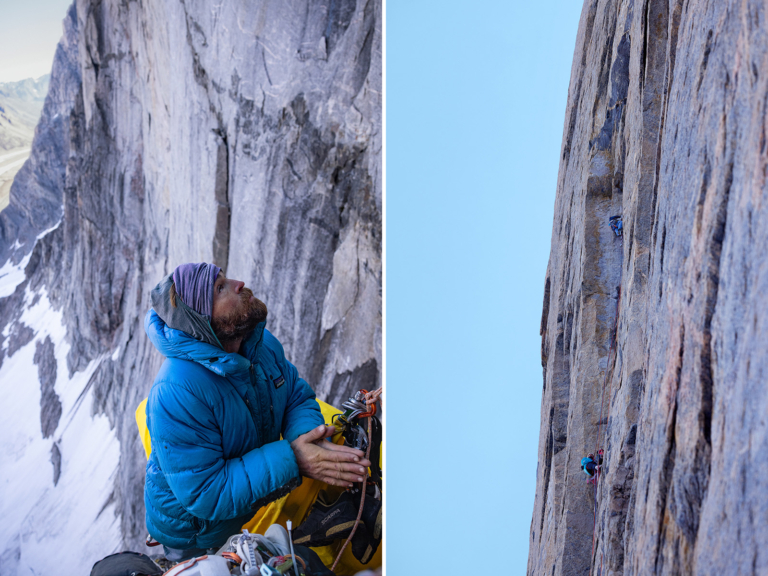
Left: Preparing for another day of vertical exploration. The Mirror Wall is north facing, and it’s in the Arctic, so it’s twice as cold!
Right: The highpoint. After having climbed almost 1,000 feet of blank, featureless-looking rock, we arrived in this cul-de-sac—a dihedral that proved too difficult for our free-climbing and aid-climbing skills. We were almost 100 feet away from a crack system that seemed to lead to the summit. Unwilling to place a bolt ladder, it was time to let go and go down.
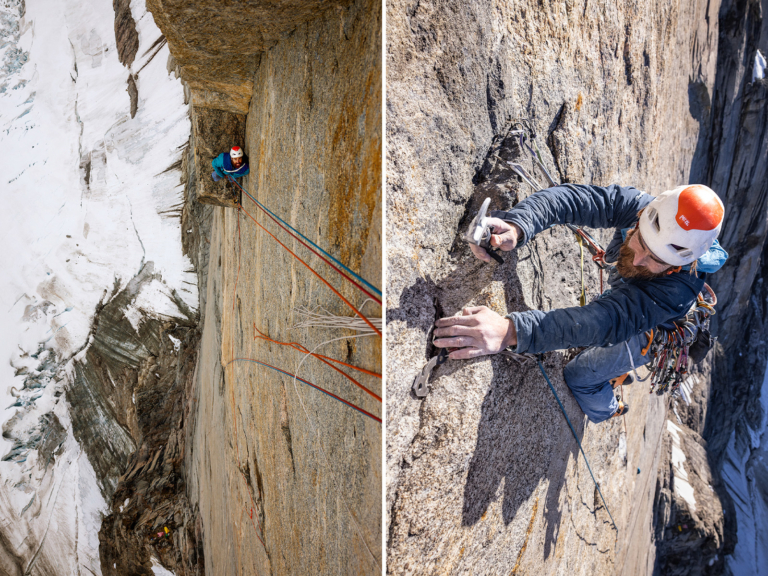
Left: Respite from hanging in my harness for nine hours. In the bottom-center of the picture, nearly 1,000 feet lower, you can see our pink and yellow portaledges set up next to a ledge about 1,300 feet up the wall. Each day, we would fix static ropes from there, ascend the ropes to our highpoint, try and push it higher, then zip down to our portaledge camp at the end of the day.
Right: Our attempt on the Mirror Wall consisted of a mix of hard aid climbing and free climbing. Here, I’m making a nest of bird-beak pitons before committing to some difficult free climbing.
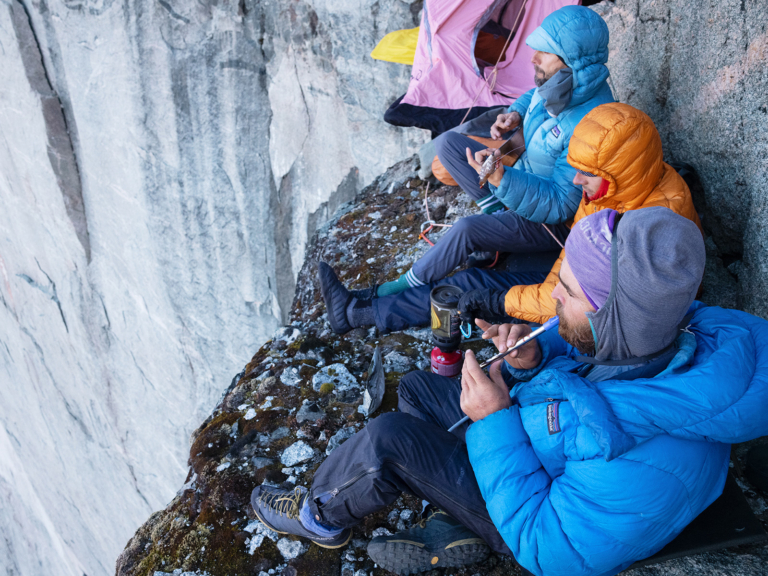
A moment of relaxation and recharging. Our portaledge jam band consisted of Nico on the guitar, Franco on the Buddhist chants and me on the tin whistle.
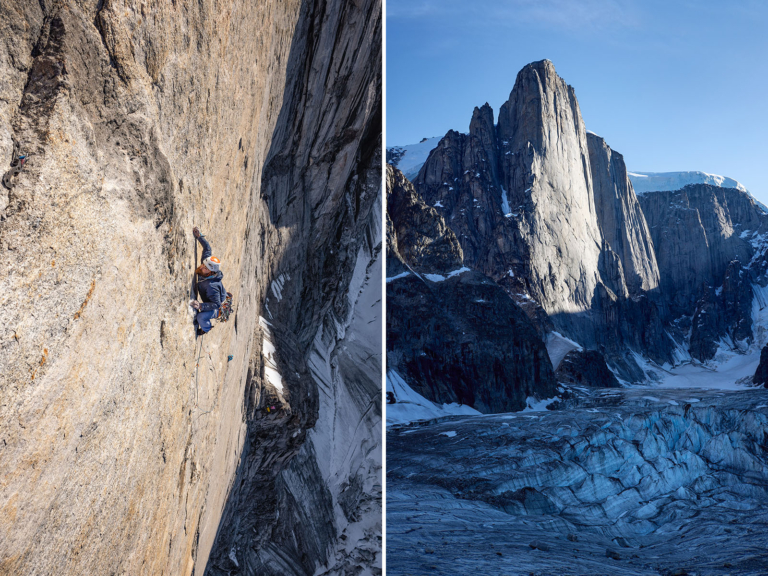
Left: Previous expeditions to Mirror Wall used helicopters for the approach. Our team arrived by boat and walked 10 days through the valley to get to the route.
Right: Nico Favresse, Ben Ditto, Franco Cookson and I spent 10 days on the Mirror Wall before choosing to let the impossible live on.
